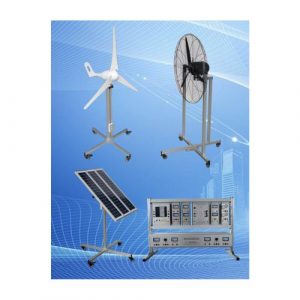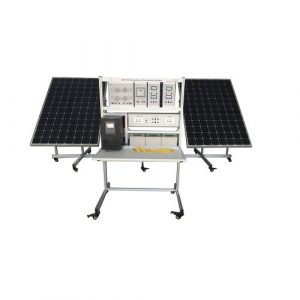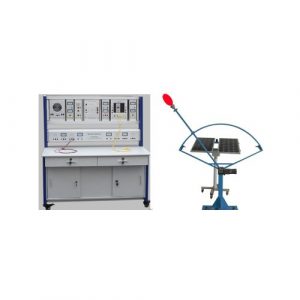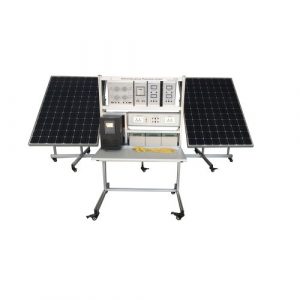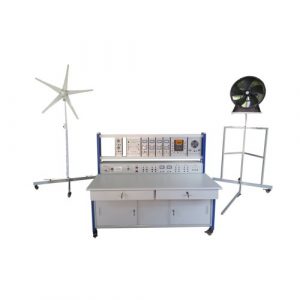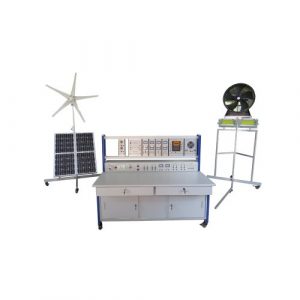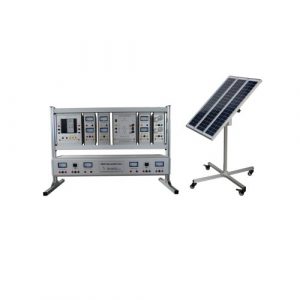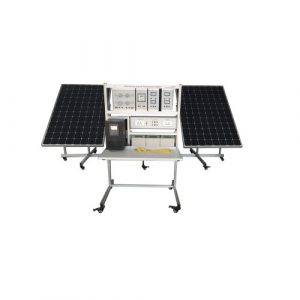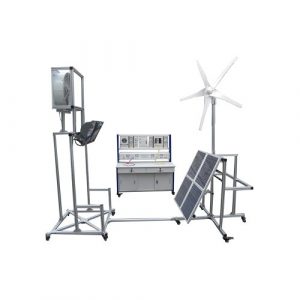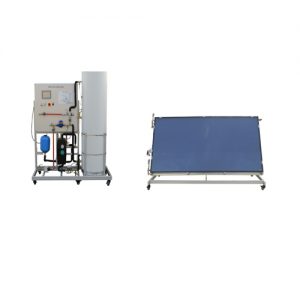- Description
- Inquiry
TB-230313-V-3.5 Mobile Teaching Bench On Fuel Cell Technology Educational Training Equipment Green Energy Training Equipment
1 Equipment introduction
1.1 Overview
This training device is constructed with an aluminum profile frame and is mainly composed of a hydrogen generator, a pressure reducing valve, a solenoid valve, a gas flow meter, a fuel cell with a DC converter, and several loads.
During the operation of this training device, it mainly includes two processes: gas supply and power supply of the fuel cell.
In this training device, a hydrogen generator generates hydrogen, and the generated hydrogen passes through a pressure reducing valve, a solenoid valve, and a gas flow meter in sequence into a fuel cell with a DC converter and provides fuel for it. One side of the fuel cell It is connected to the air to provide the required oxygen (O2) for the fuel cell. The catalyst promotes the redox reaction between the fuel (H2) and oxygen (O2), converts chemical energy into electrical energy, and supplies the generated electrical energy to the load. its work.
The pressure reducing valve is used to reduce the pressure of the air source and stabilize it to a fixed value so that the regulating valve can obtain stable air source power for regulatory control;
Solenoid valves can be used to control and regulate fluid media (hydrogen);
A gas flow meter can be used to calculate the volume of incoming hydrogen;
By connecting the fuel cell to the load, and using a multimeter to measure under different working conditions, you can observe the changes in voltage before and after, thereby determining the changes in fuel cell power before and after.
Therefore, this equipment can complete the following practical training projects:
The first part of the hydrogen production process (use a hydrogen generator to produce hydrogen or bring your own hydrogen bottle);
Part 2: Introduction to fuel cells;
Part 3: Gas supply process of fuel cell;
Part 4: The power supply process of fuel cells;
Part 5: Use of software;
Through the above practical training operations, students can develop corresponding knowledge and skills, and are suitable for related teaching and skills training.
1.2 Features
(1) The training platform adopts an aluminum profile column frame structure, which is simple and elegant as a whole. It is equipped with universal wheels at the bottom and can be flexibly moved.
(2) The combination of software and hardware can complete training content in a variety of subjects.
(3) The training platform has a good safety protection system.
2 Technical parameters
Input power supply: single-phase three-wire 220V, 50Hz
size:1340mm*760mm*2200mm
weight:<154kg
Ambient temperature: -10℃~+40℃
Relative humidity: <85% (25℃)
3 Components list and detailed introduction
3.1 Main part
| No | Name |
| 1 | Aluminum profile frame |
| 2 | Hydrogen generator |
| 3 | Hydrogen cylinder |
| 4 | Pressure reducing valve |
| 5 | Barometer |
| 6 | Fuel cell with DC converter |
| 7 | Load module (normal load) |
| 8 | Load module (electronic load) |
| 9 | computer |
| 10 | Universal wheel |
| 11 | The electromagnetic valve |
3.2 Equipment configuration list
| No | Name | Qty |
| 1 | Hydrogen generator | 1 |
| 2 | Hydrogen cylinder | 1 |
| 3 | beaker | 1 |
| 4 | Potassium hydroxide solid particles | a bottle |
| 5 | Pressure reducing valve | 1 |
| 6 | The electromagnetic valve | 1 |
| 7 | Barometer | 1 |
| 8 | Load module (normal load) | 1 |
| 9 | Load module (electronic load) | 1 |
| 10 | Fuel cell with DC converter | 1 |
| 11 | computer | 1 |
| 12 | Universal wheel | 4 |
| 13 | Mobile aluminum test bench | 1 |
3.3 Accessories
| No | Name | Qty |
| 1 | safety plug with socket | 3 |
| 2 | Multiple sockets | 1 |
| 3 | 4mm safety connection cable(red) | 5 |
| 4 | 4mm safety connection cable(black) | 5 |
| 5 | multimeter | 2 |
| 6 | J-TAG cable | 1 |
| 7 | Hydrogen connection tube | 1 |
| 8 | Mobile hard drive | 1 |
4 practical training projects
The first part of the hydrogen production process (use a hydrogen generator to produce hydrogen or bring your own hydrogen bottle)
Part 2 Introduction to Fuel Cells
Part 3: Gas Supply Process of Fuel Cell
Part 4 The power supply process of fuel cells
(1) DC-DVD converter (used to obtain stable DC voltage)
(2) Connect ordinary load
(3) Connect the electronic load
Part 5: Use of software






